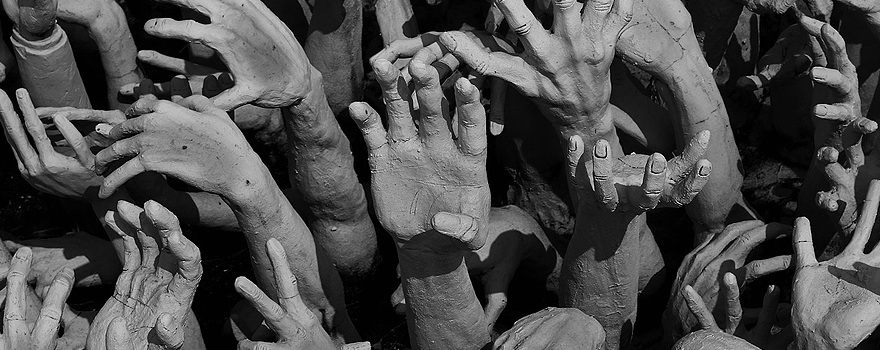
▲ Buddhist sculpture 'Hands from Hell', from the Watrongkhun White Temple, Thailand [Pixabay].
COMMENTARY / María Martín Andrade
Human trafficking is a global phenomenon affecting the entire planet. However, with 11.7 million victims, Asia-Pacific is currently the main hub of operations for organized crime groups that trade in people. Thanks to favorable conditions - natural disasters and migrant and refugee crises, result in a large issue of displacements across the geography of South Asia - criminal groups are in the best status to operate.
Despite ASEAN's efforts to foster international cooperation among its member countries for an effective fight, regional differences and corruption often prevail over other factors. At other times, it is the governments themselves that benefit from migration flows by facilitating forced labor situations, thus contributing to the fact that Southeast Asia continues to have the highest numbers of victims of sexual and labor exploitation. Most migration in ASEAN countries is intra-regional, with Indonesia, Malaysia and Thailand being the main destinations for migrants.
Focus on Thailand
In Thailand, 72% of immigration in 2010 was illegal, and is now estimated to exceed 1 million people, with the majority being from Myanmar and other neighboring countries such as Cambodia, Vietnam and Laos. The explanation why Thailand has become a major destination for migrants, and therefore an important playground for human trafficking organizations, lies in the combination of slow population growth, compared to other countries in the region, and high economic development that began to be experienced from the 1990s onwards. According to the ASEAN PostThailand has one of the fastest growing markets among ASEAN members, which has prompted the government to continue working on development its infrastructure, for which immigration is key.
At the beginning of the boom, Thailand recruited immigrants without having legislation to deal with the phenomenon, which resulted in their promoters taking advantage of the status to exploit those who arrived without knowledge of Thai language and laws. It was not until the arrival of the government of businessman Thaksin Shinowatra that a registration system granting temporary permits was introduced. However, when their validity expired, many of these permits were not renewed, thus leaving thousands of workers exposed to illegality and, thus, to sexual exploitation and other class of forced labor in sectors such as agriculture, fishing, domestic services or industry.
On the other hand, the lack of legal regulation of recruitment agencies, to which the Thai government has paid no particular attention, has allowed these agencies to dispose of migrants as they wish without suffering any reprisals. Weak legislation combined with minimal safety conditions for the victims, with only extreme physical abuse being punishable as a criminal offense, creates a status of almost total helplessness for the exploited, who also feel unable to turn to the authorities for fear of being deported.
Human trafficking: challenges and international cooperation
Organized crime in Southeast Asia cannot be tackled without first confronting corruption in the countries themselves, as many officials benefit from facilitating the crossing of their borders by such organizations and illegal immigrants. In addition, the lack of information and intelligence analysis by the law enforcement agencies themselves, together with the difficulties offered by a complicated orography with vast forested and jungle areas that are very difficult to control, hinder investigations and cause the authorities to operate blindly.
With the intention of establishing a common legal basis, several countries in the region have signed the United Nations International Convention against Transnational Organized Crime, with the goal of eliminating legislative differences and providing a means to combat organized crime. However, although Thailand has signed it, along with Singapore and Brunei, it has not yet ratified it. Other solutions have also been proposed by ASEAN, with the creation of Heads of Specialist Strategic Units, whose intention is to promote partnership and cooperation between countries by exchanging information. In addition, a Regional Support Office has been set up to establish guidelines for the prevention, arrest and protection of victims.
Despite the apparent interest of the international sphere, Asia-Pacific countries prefer to be governed by bilateral relations that allow them to be selective in the rules they choose to apply, and cooperation is not possible if the interests of each state are paramount. They will continue to be willing to sign agreements as long as they are not strictly bound by them because, as in the case of Thailand, the concern coming from outside is greater than that perceived domestically.
The fight against human trafficking in Asia-Pacific has a long way to go. The measures adopted cannot be effective if there is no firm intention on the part of the countries involved to put an end to this problem. Human trafficking is the profitability of a harm, a business from which certain dominant sectors benefit, so in order to achieve fruitful international cooperation, the South Asian states would have to perceive it as the scourge it is for their society.
BIBLIOGRAPHY
Kranrattanasuit, N. (2014). ASEAN and Human Trafficking: Case Studies of Cambodia, Thailand and Vietnam. International Studies in Human Rights, Volume:109, 4-104.
Henry, N. (2018). Asylum, Work, and Precarity: Bordering the Asia-Pacific. University of Warwick.
Sansó-Rubert, D. (2011). Transnational Organized Crime in Asia-Pacific: Implications for Regional and International Security. University of Santiago de Compostela-CESEDEN, 159-189.